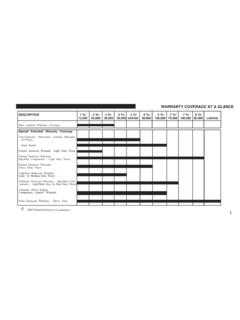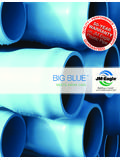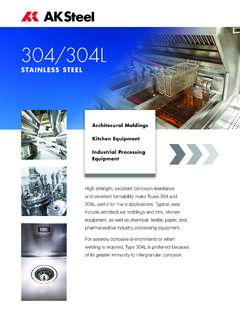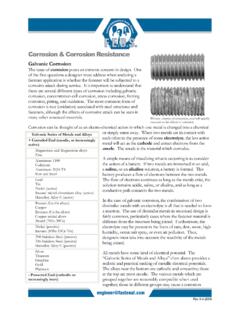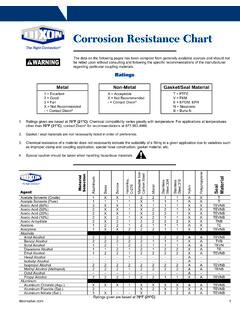Transcription of AWT – Standards for Corrosion Rates
1 Association of Water Technologies The Voice of the Water Treatment Industry! AWT Standards for Corrosion Rates by Bennett P. Boffardi, , FNACE. Position: (from direction of flow) 1: Aluminum 2: Galvanized 3: Mild Steel 4: Brass 5: Copper 6: Nickel 7: Stainless Steel FACTORS in Obtaining & Interpreting Corrosion coupon Values: Type of Industry Duration of coupon in Test Rack coupon Placement & Orientation Temperature & Flow Characteristics passing over the coupon Water Quality & Process Contamination Level of Treatment & coupon Rack Design Type of Industry Acceptable values from HVAC systems may not be achievable in a refinery or chemical plant and industrial plants may not be able to achieve the some degree of protection as those found in institutional or commercial sites. Duration in coupon Test Rack Short-term durations (30-days or less) usually have higher Corrosion Rates compared to coupons remaining in the rack for longer terms (90 days).
2 With short terms, coupon surfaces are active and have not acclimated to the environment, resulting in greater metal loss from the coupon longer-terms negate this effect. As the metal coupon corrodes, the Corrosion products can act as a barrier reducing the rate of further attack for coupons left in racks for excessively long terms. The recommended time frame for coupons in a test rack is approximately 90 days. coupon Placement & Orientation Should follow the galvanic series, with the most active metal or alloy placed in the number one position downstream of the water, and so forth this procedure prevents the more noble metal or alloy from cathodically depositing on the active metal or alloy. Coupons should be placed in the rack such that water flows from the back of the coupon . Coupons should be orientated with the broad face in a vertical position, reducing the accumulation of debris onto the face of the coupon , which can accelerate Corrosion .
3 Temperature & Flow Characteristics Water flow through a coupon test rack should be 3-5 feet per second as high velocities can cause erosion on soft alloys and low velocities can cause particulate matter to settle onto the coupon resulting in underdeposit ( Corrosion ) attack. Discharged rack water should be open to the atmosphere to eliminate back pressure. Corrosion racks should be connected to the cooling tower riser, where the water is the warmest lower temperature supply line connections will bias results with lower Rates . 1 of 1 Association of Water Technologies The Voice of the Water Treatment Industry! 2 of 2 Water Quality & Process Contamination pH, temperature, conductivity, TDS and SS will influence Corrosion (attack) on coupons. Process contaminations can accelerate attack sour hydrocarbon leaks will increase Corrosion due to sulfide attack on copper or carbon steel ammonia leaks can decrease attack on carbon steel due to higher pH, yet accelerate Corrosion (attack) on copper.
4 Level of Treatment & coupon Rack Design Unpassivated coupons in a maintenance level chemical treatment system will have higher Corrosion Rates compared to passivated coupons unpassivated coupons should be used if the chemical treatment is at a level to passivate the system. Corrosion racks should not be coupled to brass or galvanized steel valves brass will cause copper ions to deposit onto steel (and accelerate) Corrosion ; galvanized will release zinc ions, which will act synergistically with the chemical treatment to provide improved Corrosion protection to carbon steel. Classification of Corrosion Rates for Open Recirculating Cooling Water Systems ( Corrosion Rates , mpy) Description Carbon Steel Copper Alloys Negligible or Excellent Less than or equal to 1 Less than or equal to Mild or Very Good 1 to 3 to Good 3 to 5 to Moderate to Fair 5 to 8 to Poor 8 to 10 to 1 Very Poor to Severe >10 >1 Classification of Corrosion Rates for Closed Recirculating Cooling Water Systems ( Corrosion Rates , mpy) Description Carbon Steel Copper Alloys Excellent Less than or equal to than or equal to Good to to Moderate to to Poor to 1 to Very Poor to Severe Greater than or equal to 1 Greater than or equal to Source: Bennett P.
5 Boffardi, , FNACE. " Standards for Corrosion Rates ", AWT Analyst, Spring 2000



